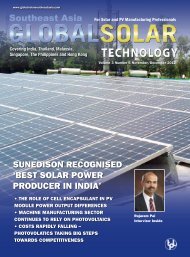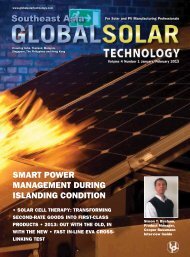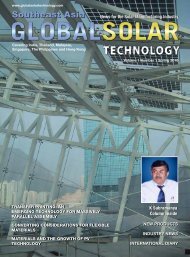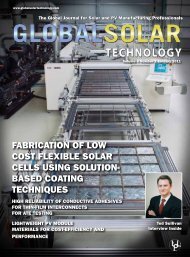Download the PDF - Global Solar Technology
Download the PDF - Global Solar Technology
Download the PDF - Global Solar Technology
Create successful ePaper yourself
Turn your PDF publications into a flip-book with our unique Google optimized e-Paper software.
Spice Village Resort, India, gets off <strong>the</strong> grid<br />
(SMC) of 7.5 kW nominal capacity, was<br />
selected because <strong>the</strong> SMC has a high<br />
800VDC input voltage capacity, allowing<br />
<strong>the</strong> PV array to be configured with more<br />
PV modules in series than if standard PV<br />
string inverters were selected. This resulted<br />
in reducing <strong>the</strong> DC cabling size of <strong>the</strong> PV<br />
array and simplifying <strong>the</strong> PV array installation.<br />
In addition, <strong>the</strong> SMA SMC inverters<br />
feature one of <strong>the</strong> best maximumpowerpoint-tracking<br />
(MPPT) efficiency with its<br />
OptiTrac Tracking, allowing optimum use<br />
of <strong>the</strong> PV energy produced. An installed<br />
Sunny Webox allows detailed monitoring<br />
of <strong>the</strong> PV energy contribution.<br />
Three SMA Clusters, each featuring<br />
three dual-mode SMA Sunny Island 5048<br />
inverter-chargers, convert <strong>the</strong> excess of AC<br />
energy not used by <strong>the</strong> load into DC energy<br />
to charge <strong>the</strong> battery banks. When required,<br />
<strong>the</strong> DC energy stored in <strong>the</strong> batteries will<br />
be converted into AC energy to power <strong>the</strong><br />
AC load. The SMA Sunny Island 5048 is<br />
a highly efficient, easy-to-configure dualmode<br />
inverter-charger of 5 kW at 48V. Its<br />
intelligent battery management system<br />
helps ensure maximum battery life.<br />
The energy produced by <strong>the</strong> thinfilm<br />
PV modules is stored in 72 Trojan<br />
deep-cycle flooded IND29-4V Industrial<br />
batteries. Trojan batteries were chosen by<br />
TeamSustain due to <strong>the</strong>ir reputation for<br />
high quality and reliability, <strong>the</strong> fact that<br />
<strong>the</strong>y were made in <strong>the</strong> USA and because<br />
<strong>the</strong> size of <strong>the</strong> Industrial batteries met<br />
<strong>the</strong> specifications of <strong>the</strong> project design.<br />
Flooded deep-cycle batteries were chosen<br />
for <strong>the</strong> project over valve-regulated leadacid<br />
(VRLA) batteries because of <strong>the</strong>ir<br />
affordability and durability. Since <strong>the</strong><br />
resort has a maintenance program in place,<br />
watering <strong>the</strong> batteries periodically with<br />
distilled water will not be an issue. Trojan’s<br />
Industrial batteries have wide plates which<br />
allow for more electrolyte to be stored at<br />
<strong>the</strong> top of <strong>the</strong> plates, allowing for longer<br />
intervals between watering.<br />
The battery bank size was designed by<br />
TeamSustain for a daily usage of maximum<br />
50 percent depth of discharge, with each<br />
battery providing a 1,361 Amp-hour<br />
capacity at C10 at 1.80VPC. There are<br />
three 2,722 Ah at 48V battery banks in<br />
<strong>the</strong> system, totaling 8,166 Ah capacity.<br />
Each 48V battery bank, connected to one<br />
SMA Cluster, is configured as two strings<br />
in parallel, each string consisting of eight<br />
Trojan IND29-4V batteries in series.<br />
Trojan’s deep-cycle flooded battery<br />
technology requires simple maintenance<br />
to ensure maximum battery life, which<br />
includes adding distilled water to <strong>the</strong> individual<br />
cells regularly.<br />
Trojan’s Industrial line of flooded<br />
deep-cycle batteries is designed for 1,500<br />
cycles at 80 % depth of discharge and is<br />
specifically engineered to withstand <strong>the</strong><br />
rigorous conditions of renewable energy<br />
applications including extreme temperatures,<br />
remote locations and <strong>the</strong> intermittent<br />
nature of solar power generation.<br />
These batteries are designed to be cycled<br />
regularly and are engineered to perform<br />
optimally under conditions where <strong>the</strong><br />
batteries operate in a partial state of<br />
charge; a common occurrence in renewable<br />
energy applications due to <strong>the</strong> varying<br />
levels of irradiance, temperature, and available<br />
sun hours.<br />
The anticipated payback time for <strong>the</strong><br />
PV system is five years. Spice Village has<br />
applied for a 30% subsidy from <strong>the</strong> Indian<br />
government on capital costs as part of <strong>the</strong><br />
Jawaharlal Nehru National <strong>Solar</strong> Mission<br />
(JNNSM) Rooftop Plant Program. This<br />
project is also eligible to earn carbon<br />
credits since <strong>the</strong>re is an expected carbon<br />
reduction of 256 tons of CO₂. Overall,<br />
Spice Village expects to save nearly $45,000<br />
per year by switching to solar energy.<br />
www.globalsolartechnology.com<br />
<strong>Global</strong> <strong>Solar</strong> & Alternative Energies – May/June 2013 – 25
















